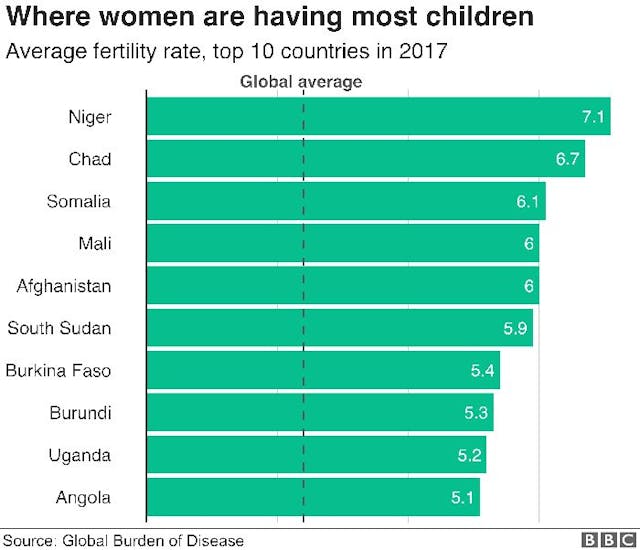
Hearse arrives at Illinois Planned Parenthood to 'pick someone up'
Nancy Flanders
·
Nearly half of countries have ‘insufficient children’ to maintain populations
According to the BBC, new research published in The Lancet — funded by the Bill and Melinda Gates Foundation — shows something that researchers are calling a “huge surprise.” That surprise is that the “fertility rate falls meant nearly half of countries were now facing a ‘baby bust’ – meaning there are insufficient children to maintain their population size.” Countries need a fertility replacement rate of 2.1 to have stable populations.
The research tracks fertility rates from 1950 to 2017. The BBC notes:
In 1950, women were having an average of 4.7 children in their lifetime. The fertility rate all but halved to 2.4 children per woman by last year.
But that masks huge variation between nations.
The fertility rate in Niger, west Africa, is 7.1, but in the Mediterranean island of Cyprus women are having one child, on average.
In the UK, the rate is 1.7, similar to most Western European countries.
While this demographic winter is very real — as countries in this “baby bust” will have a tendency to continue their population decline, unable to support their aging populations — the study notes that worldwide population is still increasing.
Article continues below
Dear Reader,
In 2026, Live Action is heading straight where the battle is fiercest: college campuses.
We have a bold initiative to establish 100 Live Action campus chapters within the next year, and your partnership will make it a success!
Your support today will help train and equip young leaders, bring Live Action’s educational content into academic environments, host on-campus events and debates, and empower students to challenge the pro-abortion status quo with truth and compassion.
Invest in pro-life grassroots outreach and cultural formation with your DOUBLED year-end gift!
Most of the higher fertility rates are in sub-Saharan Africa and in Asia. This might explain why there has been much focus by pro-abortion groups in recent years on what one African pro-life leader calls a new “colonization” of African countries, with organizations pushing abortion and contraception on these continents in an effort to curb population growth. Obianuju Ekeocha of Culture of Life Africa recently reiterated that education and clean food and water don’t seem to be the main concern of “the wealthiest and most prominent donors.” Instead, notes the Catholic Standard, “population programs receive more donated funds than education, health care, or clean water. African countries receive about two billion donated condoms every year, which costs about $17 million….”

READ: Is eugenics the real reason that European countries are pushing ‘family planning’ in Africa?
The article claims that “three key factors” have contributed to the baby bust:
Fewer deaths in childhood meaning women have fewer babies
Greater access to contraception
More women in education and work
The BBC also claims that “[w]ithout migration, countries will face ageing and shrinking populations” and “affected countries will need to consider increasing immigration, which can create its own problems, or introducing policies to encourage women to have more children, which often fail.”
Dr. George Leeson of the Oxford Institute of Population Ageing told the BBC that “even the idea of retiring at 68, the current maximum in the UK, will be unsustainable” at such low fertility rates.
Despite its increasing population over the decades, even China, with its longstanding One-Child Policy (now Two-Child Policy), now has a replacement rate of only 1.5, with the BBC admitting that China’s skewed boy-to-girl ratio due to “sex-selective abortion and… the possibility of female infanticide” contributing to the country’s fertility problems.
Live Action News is pro-life news and commentary from a pro-life perspective.
Contact editor@liveaction.org for questions, corrections, or if you are seeking permission to reprint any Live Action News content.
Guest Articles: To submit a guest article to Live Action News, email editor@liveaction.org with an attached Word document of 800-1000 words. Please also attach any photos relevant to your submission if applicable. If your submission is accepted for publication, you will be notified within three weeks. Guest articles are not compensated (see our Open License Agreement). Thank you for your interest in Live Action News!

Nancy Flanders
·
Guest Column
Right to Life UK
·
Issues
Angeline Tan
·
Issues
Bridget Sielicki
·
Issues
Nancy Flanders
·
Politics
Bridget Sielicki
·
Human Interest
Kelli Keane
·
Activism
Kelli Keane
·
Politics
Kelli Keane
·
Human Interest
Kelli Keane
·
Abortion Pill
Kelli Keane
·